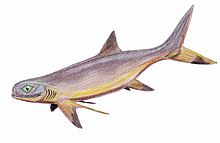Our website is made possible by displaying online advertisements to our visitors.
Please consider supporting us by disabling your ad blocker.
Symmoriiformes
| Symmoriiformes Temporal range: Late Devonian - Early Permian (Members of the family Falcatidae might have survived until the Early Cretaceous in Europe.)
| |
|---|---|

| |
| Symmorium | |
| Scientific classification | |
| Domain: | Eukaryota |
| Kingdom: | Animalia |
| Phylum: | Chordata |
| Class: | Chondrichthyes |
| Order: | †Symmoriiformes Zangerl, 1981 (sensu Maisey, 2007) |
| Families and genera | |
Symmoriiformes is an extinct order of cartilaginous fish. Originally named Symmoriida by Zangerl (1981),[1] the name has since been corrected to Symmoriiformes to avoid confusion with a family.[2] The symmoriiform fossils record begins during the late Devonian, and most had become extinct by the start of the Permian, with the genus Dwykaselachus from the Artinskian-Kungurian of South Africa being the latest known uncontroversial occurrence.[3] Teeth described from the Valanginian of France[4] and Austria[5] indicate that members of the family Falcatidae might have survived until the Early Cretaceous; however, it has since been proposed that these teeth more likely belonged to neoselachian sharks.[6]
- ^ Zangerl, Rainer (1981). Chondrichthyes I: Paleozoic Elasmobranchii. Handbook of paleoichthyology. Stuttgart; New York: G. Fischer. pp. 1–115. ISBN 978-0-89574-155-4.
- ^ Maisey, John G. (31 October 2007). "The braincase in Paleozoic symmoriiform and cladoselachian sharks". Bulletin of the American Museum of Natural History. 307: 1–122. doi:10.1206/0003-0090(2007)307[1:TBIPSA]2.0.CO;2. S2CID 85643864.
- ^ Coates M.; Gess R.; Finarelli J.; Criswell K.; Tietjen K. (2016). "A symmoriiform chondrichthyan braincase and the origin of chimaeroid fishes". Nature. 541 (7636): 208–211. doi:10.1038/nature20806. PMID 28052054. S2CID 4455946.
- ^ Guillaume Guinot; Sylvain Adnet; Lionel Cavin & Henri Cappetta (2013). "Cretaceous stem chondrichthyans survived the end-Permian mass extinction". Nature Communications. 4: Article number: 2669. doi:10.1038/ncomms3669. PMID 24169620.
- ^ Feichtinger, Iris; Engelbrecht, Andrea; Lukeneder, Alexander; Kriwet, Jürgen (2020-07-02). "New chondrichthyans characterised by cladodont-like tooth morphologies from the Early Cretaceous of Austria, with remarks on the microstructural diversity of enameloid". Historical Biology. 32 (6): 823–836. doi:10.1080/08912963.2018.1539971. ISSN 0891-2963. S2CID 92392461.
- ^ Alexander O. Ivanov (2022). "New late Carboniferous chondrichthyans from the European Russia". Bulletin of Geosciences. 97 (2): 219–234. doi:10.3140/bull.geosci.1845. S2CID 249479522.
Previous Page Next Page


